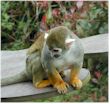|
Primates
Primates
Family Tree
Primate Conservation |
|
Primates: Classification and a quick note on word endings

 There are
so many species of living things on Earth, zoologists have to classify and
categorise not only to make sense of things but also to aid identification.
Talk to a gardener from China about snap dragons and they most likely won't
know what you're talking about. However, mention Antirrhinum majus and you're
talking the same language! There are
so many species of living things on Earth, zoologists have to classify and
categorise not only to make sense of things but also to aid identification.
Talk to a gardener from China about snap dragons and they most likely won't
know what you're talking about. However, mention Antirrhinum majus and you're
talking the same language!
The
classification system used today is based on the system introduced by the
Swedish scientist Linnaeus.
However, any system is not fixed and zoologists are constantly "tweaking" the
system to reflect new knowledge. And they don't always agree! Which is not
surprising considering the complexities of life on Earth, living and extinct.
And it is also why you might see minor differences in classification
when researching. The generally accepted way of classifying all life is as follows:
| Kingdom |
There are 5 kingdoms.
Animals,
Plants, Fungi, Protista (single celled organisms that have a
cell nucleus; includes slime molds and some algae), Monera (single
celled organisms that do not have a cell nucleus. Includes various types
of bacteria). |
| Phylum |
Each Kingdom is split further into Phyla.
For example, there are around 30 phyla in the animal kingdom, some of
which are further sub divided into Sub-Phyla.
The Phylum Chordata is
further split into 3 Sub-Phyla, one of which is the vertibrate animals
(animals with backbones). |
| Class |
Each Phylum is further split into Classes.
For example the Vertibrates are divided into 7 classes which include
fish, amphibians, reptiles, birds and mammals. |
| Order |
Each Class is divided into Orders.
An example of an order is Primates,
which is a sub division of the class Mammalia.
Orders may be further
divided into sub orders and infraorders. |
| Family |
Each Order is divided into Families.
Very often we have super families and
families. For example Hominoidea is the super family of apes and includes
the family of Gibbons, Hylobatidae. |
| Genus |
This is a group of closely related species.
For example there are several species of Colobus monkeys, all belonging
the the genus Colobus. |
| Species |
A species is usually designated by
the genus (capitalised) followed by the species name.
For example, the
black colobus monkey is designated Colobus satanas. |
Three examples:
You can use the Primates
Tree we have prepared to
trace these particular classifications.
| Classification |
Human |
Red Uakari  |
Chimpanzee  |
| Kingdom |
Animalia |
Animalia |
Animalia |
| Phylum |
Chordata |
Chordata |
Chordata |
| Sub-Phylum |
Vertibrata |
Vertibrata |
Vertibrata |
| Class |
Mammalia |
Mammalia |
Mammalia |
| Order |
Primates |
Primates |
Primates |
| Sub Order |
Anthropoidea |
Anthropoidea |
Anthropoidea |
| Infra Order |
Catarrhini |
Platyrrhini |
Catarrhini |
| Super Family |
Hominoidea |
Ceboidea |
Hominoidea |
| Family |
Hominidae |
Cebidae |
Pongidae* |
| Genus |
Homo |
Cacajao |
Pan |
| Species |
Homo sapien |
Cacajao rubicundus |
Pan troglodytes |
*Recently there have been moves to include the great
apes within the family Hominidae. In this scheme Homininae is a subfamily
of Hominidae, and includes Homo sapiens and some extinct relatives, as well
as the gorillas and the chimpanzees (not orangutans).
To distinguish between
humans, chimps and gorillas, another term Hominini, which refers to a Tribe
(this occupies the space between family and genus), is used to describe
all the human species that have ever lived but which doesn't include chimps
and gorillas.
If
this all sounds like complicated madness, the reason is that recent DNA
sequencing has shown that the ancestors of chimps, gorillas and humans
split from the orang-utan line first. Next came the chimp/human and gorilla
split. Finally chimp and human ancestors split to produce the 3 species alive
today. Diagrammatically, it looks something like this, with time going
from past to present, with the oldest common ancester located at the top
of the diagram.

If you look at the primate
family tree, you will notice
we have used the old classification, simply becasue it is the most commonly
used one at present.
However, if you look closely you will see that it doesn't really represent
the evolutionary relationship between the great apes and humans as shown
above.
Further reading on classification:
Palomar
College has prepared a very readable classification of living things.
Flashcards and crossword puzzles also included.
Animal
Diversity Web. Another very good site. Includes pictures, sounds, information
and classification.
Primates.com Excellent
fact sheets and articles on individual primates as well as a classification
table.
Carl
Linnaeus Biography
The
Franklin Institute Readable explanations and activity ideas.
PlantExplorers for
information on plant classification.
Enchanted
Learning for a simple treatment for younger children
Rediscovering
Biology for a detailed treatment suitable for A level onwards.
Word Endings:
When zoologists assign names to families there is a set of
rules they follow. The following applies to animal classification.
| Superfamily |
Name ends in "-oidea" |
| Family name |
Name ends in "-idae" |
| Subfamily |
Name ends in "-inae" |
| Tribe |
Name ends in "-ini" |
| Subtribe |
Name ends in "-ina" |
Note the suffix -oid is from the Greek and means resembling.
The prefix homo means man, therefore the word hominoid means man like. |